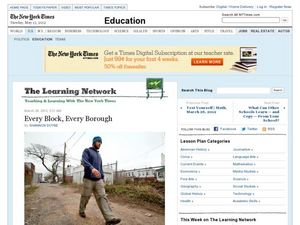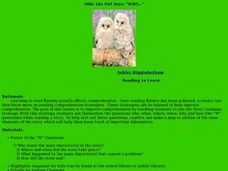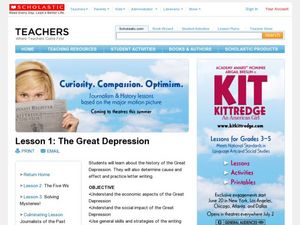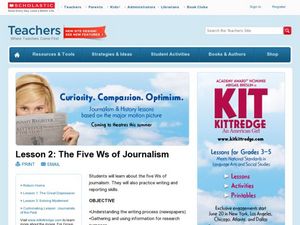Student Handouts
The Five W's and How
Here is a great graphic organizer for ensuring that young researchers and writers cover all their bases when brainstorming a topic by considering the five W's (who, what, where, when, and why) and how.
Curated OER
The 5 W's
Examine how to answer who, what, when, where, and why when reading text. Young writers listen to the story Skeleton Hiccups, and as a class answer and discuss the five W's. Independently they read the story silently, and write the...
Tompson Solutions
Be a Reporter (The 5 W's and an H)
Teach your class how to investigate research sources. You can start out with this presentation, which lays out a easy strategy for asking questions and taking down answers that cover the important information.
Curated OER
"Every Block, Every Borough"
From the New York Times Learning Network series, this worksheet poses 10 questions on an article entitled, "Leaving His Footprint on the City" about a man planning to walk every street in all five New York boroughs. The prompts address...
Curated OER
"It's All About Grandma Chic": Reading Informational Text
This New York Times "Learning Network" exercise on reading informational text poses 6 questions about a high-interest article on teen fashion. The article meant to be review with is resource, "More than meets the iPhone Lens", is rather...
Curated OER
On the Dots
If you want your class to practice reading informational texts and answering related questions, this short exercise from The New York Times' "Learning Network" might be helpful. It includes an article on Dippin' Dots and uses...
Curated OER
5 W Questions
Second graders practice asking the 5 W questions by reading a Boxcar Children book. In this journalism lesson, 2nd graders read a single story from the Boxcar Children series and answer the 5 W's about each specific chapter. Students...
Curated OER
Creative Problem Solving: Using the 5 W's (Who, What, Where, When, Why)
Third graders assimilate the use of the 5 W's (Who, What, Where, When, Why) when solving problems that are presented in literature and in real life situations. They use common fairy tales to solve problems that might arise at home or...
Curated OER
Summarizing with James and the Giant Peach
Elementary readers in literature groups practice summarizing chapter-by-chapter with Roald Dahl's James and the Giant Peach. Focus on main idea, supporting details, and the 5 Ws. Unfortunately, a clever "peach" graphic organizer to which...
Curated OER
Ollie the Own Says: WHO
Scholars examine the strategy of making a story map or outline to identify the main elements of a story. They discuss the who, what, where, when, why, and how of a story, in an outline form. As a class they read a short story, answer the...
Curated OER
Comprehending Through Questioning
Elementary schoolers observe and apply a variety of reading comprehension strategies. They silently read a passage out of their science textbook, and discuss answering the who, what, where, when, and how of the text. In small groups they...
Curated OER
The 5 W's of Reading
Primary students will use the five "W" questions for reading comprehension as they read silently to themselves so that they can understand and remember what they have read. They then read The Velveteen Rabbit aloud, discussing the five...
Curated OER
Build Masters: Identifying Details
Find key details in books using this note card strategy. Each reader gets six cards with the classic who, what, where, when, why, and how detail prompts. After they read the book, they choose a card and locate a key detail answering the...
Alabama Learning Exchange
Who, What, When, Where, Why, How?
Your youngsters are just starting to read texts and pull out important information. Use this graphic organizer with any text to help them practice identifying the who, what, when, where, why, and how of a text. Although the format of the...
Curated OER
Question words, question marks
Practice the five W's and question marks with a fun grammar worksheet. After copying the words who, what, where, when, why, and how, kindergartners fill the words into various questions. For extra practice, have kids come up with their...
Curated OER
Flower 5 W’s and 1 H
In this question worksheet, students use flower petals to identify important aspects of a story. Students use each petal to complete a "wh" question as well as answering "how" in the extra flower petal.
Curated OER
Who, Where, When, What and How Activity
In this 5 W's and how worksheet, students write either who, where, when, what or how for underlined phrases in sentences. One example is done for students.
Curated OER
Question Words Review
This clever reading and writing worksheet has learners read a short newspaper story on Martin Luther King, Jr., then write 6 questions about the story using the following key words: who, what, where, when, why and how. A very good...
Curated OER
Writing Exercises: Imperialism I
Examine the impact of Imperialism in relation to power and industrialization. There are three short answer questions for critical thinkers to respond to in this handout. They'll describe the relationship between Imperialism and...
Nosapo
Family Titles, Pronouns, Writing about a Person
How is your grandmother related to you? How is your cousin related to your grandmother? Learn about family relationships and pronouns with an activity that guides pupils to write two short narratives about members of their families.
Curated OER
Asking Questions
Review the basics of forming questions with this resource. ESL learners can practice forming questions, answering yes and no inquiries, and asking how long something takes. This resource provides a comprehensive exploration of the topic.
Curated OER
The Great Depression: Lesson 1
Students recognize how the causes of the Great Depression affected people and their jobs. In this Great Depression lesson, students understand that most of the time news only came from newspapers. Students write a letter as though they...
Curated OER
The Five Ws of Journalism
Students write a mock article. In this journalism lesson, students define the word "article" and learn the five W's of article writing. Students complete a worksheet and write a paragraph using what they have learned.
Curated OER
5 W's and H
Young scholars explore the 5W's and H of journalistic writing. In this 5 W's and H lesson plan, students read two articles from a newspaper and locate the 5 W's and H in the articles.

























